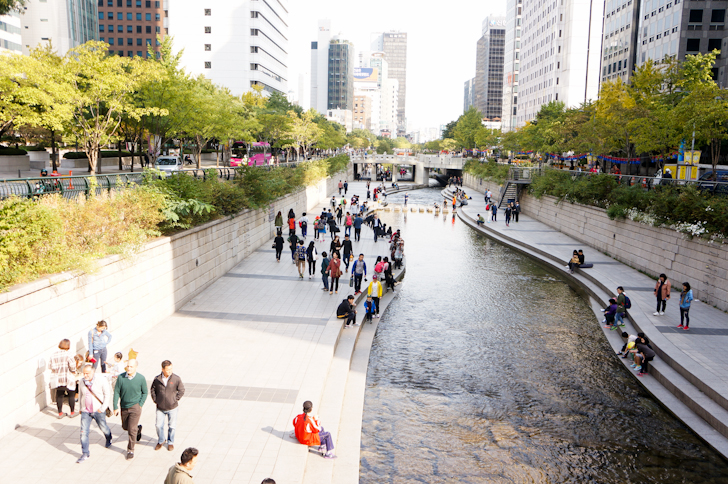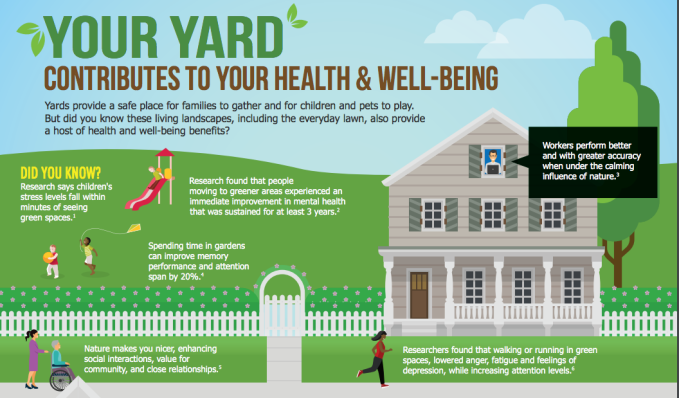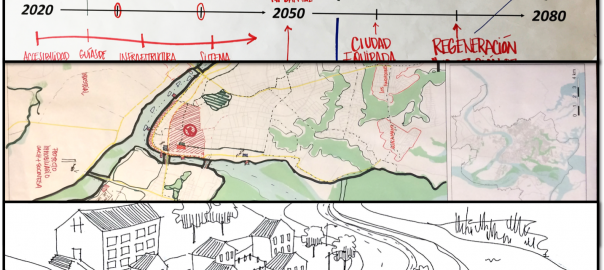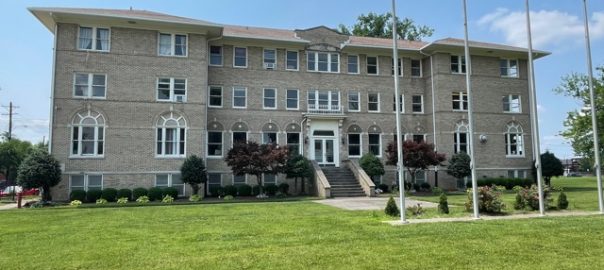Whenever I listen to the song Some Kind of Nature by the Gorillaz & Lou Reed, it makes me think about what kind of nature we are going to end up with in our cities, even though the song isn’t actually about urban nature at all. From my perspective here in New Zealand, it seems as if there are some prevailing ideas driving urban biodiversity research and urban restoration initiatives that might compromise the ecological authenticity of the nature that results from these efforts. I think we are in danger of ending up with a very watered-down and biodiversity-poor version of nature. This reduced version of nature will only exacerbate the ongoing process of shifting the baselines of expectations of what nature of urban nature is. Are we all going to end up with fake nature, and be happy with it?
Urban ecologists see nature in cities through a lens that is focused on the requirements of other species, the integrity of habitats and systems, and the potential for enhancing and restoring biodiversity to spaces that are often quite small. Urban ecology also recognises the significance and the potential of the human dimension, and acknowledges the importance of community-driven approaches to restoration projects. To be successful, restorations need to include families and communities, provide opportunities for social connections, be relevant to everyday life, encourage free choice and learning, target local issues, promote collective action, foster roles of local stakeholders, and promote direct experiences with nature. Of this list of requirements (Wilson 2011), most of the objectives are social.
While satisfying the human dimensions is essential for success, and acknowledging that restorations should be community-led, social and management constraints associated with urban restorations include “lack of ecological knowledge, lack of social acceptance of management approaches, human-wildlife conflicts, and conflicting goals based on varied views and value systems” (Clarkson & Kirby 2016; DOI: 10.1111/emr.12229). Research shows that many urban residents do not know what natural habitats look like, they aren’t able to recognise common species, they don’t know how those species function within the food web, and they do not feel comfortable in wild spaces with which they lack familiarity. If the health of cities, in terms of ecosystem services, biodiversity, and the quality of the nature experiences available to adults and children, depend on how much local communities value and know about nature, then we could be in trouble. For example, In New Zealand, many urban residents are unaware of the impacts their pet cats have on native wildlife. Many believe that it is natural for cats to kill native wildlife and it’s just a question of reaching a new equilibrium. In community consultation about cat management, I’ve heard people say that cats are just like lions, at the top of the food chain, so it is natural that they eat native birds and lizards. This attitude reflects a lack of awareness that in New Zealand there are no native terrestrial mammals except for two species of bat. I’ve also been asked if there are even any native birds within the city. A city-wide survey revealed that only a few nationally iconic bird species are recognised by most people as being native, while between a quarter and two-thirds of people are uncertain or incorrectly label other common urban native species as exotic when they are native, or native when they are exotic. This same lack of knowledge has been reported in other countries and attributed to the abundance of exotic species in home environments and the media. However, values drive community demands for green spaces and the design of these spaces. Can we rely on those things a community deems valuable if we are to achieve worthwhile ecological outcomes? Shifting baselines mean people’s concept of “wild” and “natural” will have changed.
An example of a restoration that was driven at least partly by community consultation is Boneyard Creek, which flows through Champaign, Illinois (USA), draining much of the city, including the central business district and the University of Illinois Campustown area. Poor water quality and flooding issues prompted the city and university to create a redevelopment plan. The redevelopment plan involved community consultation, and took into account social acceptance of restoration techniques, the socio-political atmosphere in neighbourhood groups, and was careful to include cultural perspectives. However, none of the reported wishes of the public reflected a desire to restore ecological function, except possibly tree planting and the creation of a pond, but rather reflected a desire for recreational spaces. The list on their website includes the following: provide landscape plantings; bike and pedestrian paths; get rid of ugly stuff; create parks; create a beautiful, safe trail; trees; create an outdoor amphitheatre; create a pond; build a beautiful bridge; convert the lumberyard into a beer garden. The completed restoration serves its primary function of increasing stormwater capacity and improving flood protection, and it provides an attractive amenity park with spaces for recreation, fulfilling four of the five defined goals, but the fifth goal of enhanced wildlife and habitat is hardly met. While some new species, such as ducks, Canada geese, turtles, and green heron have been observed on the site, the habitat value of the site has increased from being “poor/marginal” to only “sub-optimal”.
Is functionality for social purposes always going to conflict with ecological functionality? The aesthetic values of many people still reflect preferences for an Arcadian/Romantic landscape form, seen in parks with widely spaced trees that in New Zealand are usually exotic species, scattered across a mown lawn with no understorey—not the best habitat to support wildlife. Recreational spaces are not always conducive to thriving wildlife populations, except in the case of the most tolerant urban adaptors. Popular recreational spaces are likely to be noisy and well-lit. Some animals abandon areas when frequent or chronic noise interferes with their ability to pick up auditory cues, or when sounds are perceived as threats. Pedestrians interrupt bird foraging, causing birds to flee, and the presence of dogs can force birds to spend more time being vigilant, waste valuable energy, and lose foraging opportunities if they have to repeatedly fly away.
Another urban ecological restoration that is often touted as a great example of what can be achieved is the Cheonggyecheon River in South Korea. A critique of the restoration by Cho (2010; doi:10.3828/idpr.2010.05) provided a very different perspective on this restoration. Although a dramatic transformation was effected, and social goals were achieved, little public consultation was involved and the opinions of ecologists ignored. The end result has been labelled fake nature by some. The Cheonggyecheon Highway, which ran through Seoul, was seen as obsolete and an impediment to the competitiveness of the city, and so it was removed as part of an urban renewal project. It had covered the Cheonggyecheon River for decades. Now the space is occupied by a stream, lined with parks and urban-gathering spaces. It is very popular; 90,000 people visit the stream banks on an average day.

However, the result is hardly ecologically authentic. Almost all of the water that now flows between the mostly concrete banks of the Cheonggyecheon is pumped there through 11 km of pipes from another river. Cho (2010) describes the whole process as a staged political performance, launched on the eve of the Mayor’s inauguration and completed 10 months before the end of his term. Criticisms are that the Mayor used the environment as an instrument of urban development, that engineers were not open to alternative ways of water flow because it would take too long to construct, and that the approach prioritised flood control over restoration of the range of habitat types and associated species assemblages that likely existed long ago before the river was modified. Its design allows a high volume of water to flow downstream promptly, but it is not a good habitat for species. Stream engineering dictates its design, the stream bed is cleaned of moss, the water quality controlled daily, and plants are actively maintained. It is simulated nature.
But what kind of nature experience should people be entitled to? A body of literature is accumulating that supports the connection between nature contact and human well-being. Frumkin (2001; doi.org/10.1016/S0749-3797(00)00317-2) stated in his review; “As we learn more about the health benefits of contact with the natural world, we need to apply this knowledge in ways that directly enhance the health of the public”. As ecologists, we should be pondering what the consequences are of a focus on using nature to enhance human health. For example, a rise in green prescriptions has the potential to intensify use of green spaces, increasing levels of human disturbance, and even resulting in pressure to modify green spaces to make them more user-friendly, with the likely result that wilder areas will be lost.
The concept of nature contact as a therapeutic device has been widely applied, but recently more specific questions regarding the required dose of nature have been asked (Shanahan et al. 2017, doi.org/10.1093/biosci/biv032; Cox et al. 2017; doi: 10.3390/ijerph14020172). That is, for how long and how frequently do you have to be in nature to gain benefits? A few studies have tried to identify the elements of nature that people perceive and respond to. Do we enjoy the same benefits from a park filled with introduced species, as from a native woodland? These studies are presented in the context of public health gains and aim to identify minimum doses needed to effect well-being benefits. For example, Cox et al. (2017) conclude that their analysis demonstrates that quantifiable reductions in the population prevalence of poor mental health can be achieved if minimal thresholds of vegetation cover are met. My concern is that we should not be cornered into thinking about the minimum amounts of nature needed to improve human health.
While human health gain is a powerful rationale for investing in green spaces, inevitably human need will dominate all other justifications, and quantifiable needs tend to trump those that are less easy to quantify. By viewing nature as a commodity that supplies health benefits, and by identifying the minimum needed to gain benefits, we run the risk of trivialising a deep and significant affective response to nature. This view could provide an incentive to create natural spaces that are structured primarily to satisfy our well-being requirements, rather than according to ecological goals. What if we discover that we get the same well-being benefits from sitting on a lawn as from a biodiverse wetland, or woodland? And what if we gain the same benefits from a virtual experience? Chang et al. (2016; doi: 10.3390/su8101049) asserted that the absence of a relationship between physiological benefits in relation to different levels of invertebrate diversity meant that city planners should not hesitate to use ecological best practice in their designs, since settings rich in biodiversity will not necessarily influence people’s physiological well-being in a negative way. I might be accused of being cynical, but I believe that that kind of information could be used to do the exact opposite: to create spaces with minimal ecological value. The infographic below outlines all the benefits we can gain from nature in our backyard, but the yard itself is presented as just lawn with one tree. The website advises that lawns can make you feel happier.

Biodiversity has been conceptualised within economic frameworks, and can be divided broadly into use values and non-use values. Non-use values include those values relating to the feel-good factor nature provides us with—existence, altruistic, and bequest values. We should be careful not to shift the way we think about and value our natural green spaces more into the “use” part of the framework. Whatever the motivations for protecting and restoring green spaces in cities, the input of ecologists, as well as input from a well-informed public, is essential. Despite principle motivations that may not be primarily about biodiversity enhancement, such as social, hydrological, and well-being goals, and despite lack of knowledge in the public driving the project, what we end up with must have ecological value.
Yolanda van Heezik
Dunedin
References
Chang, KG, Sullivan, WC, Lin, Y-H, S, W, Chang, C-Y. 2016. The effect of biodiversity on green space users’ wellbeing – an empirical investigation using physiological evidence. Sustainability 8: 1049; doi: 10.3390/su8101049
Cho, M-R. 2010. The politics of urban nature restoration: The case of Cheonggyecheon restoration in Seoul, Korea. International Development Planning Review 32 (2) doi:10.3828/idpr.2010.05
Clarkson, BD, Kirby, CL. 2016. Ecological restoration in urban environments in New Zealand. Ecological management and restoration 17(3): 180-190.
Cox, DTC, Shanahan, DF, Hudson, HL, Fuller, RA, Anderson, K, Hancock, S, Gaston, KJ. 2016. Doses of nearby nature simultaneously associated with multiple health benefits. International journal of Environmental Research and Public health 14: 172. DOI: 10.3390/ijerph14020172.
Frumkin, H. 2001. Beyond toxicity: human health and the natural environment. American Journal of Preventative Medicine. 20:3. 234-40. doi.org/10.1016/S0749-3797(00)00317-2
Shanahan, DF, Fuller, RA, Bush, R, Lin, BB, Gaston, KJ. 2015. The health benefits of urban nature: how much do we need? BioScience 65(5): 476-485. doi.org/10.1093/biosci/biv032
Wilson, C. 2011 Effective Approaches to Connect Children with Nature, Department of Conservation: Wellington, New Zealand.












Add a Comment
Join our conversation